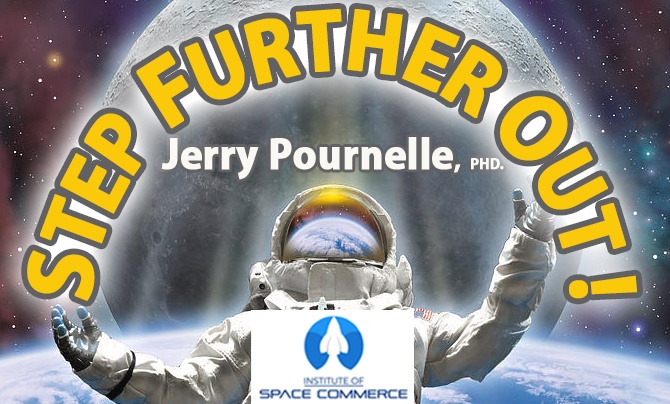FROM THE FORTHCOMING BOOK TO BENEFIT THE NON-PROFIT INSTITUTE OF SPACE COMMERCE
STEP FURTHER OUT!


The Only Limit is Nerve
by Jerry Pournelle
There is something seriously wrong with the American scientific community. We’ve lost our nerve.
Let me try to lead up to that from the back way. Some years ago a psychiatrist named Velikovsky published, for the popular press, a book questioning the basic axioms of astronomy. His theories were certainly wrong, but he did argue them rationally and present them in a book; he made no attempt to force them on anyone unless you can call persuasive writing “force”; and nowhere was it suggested that he had the ear of the President, or otherwise controlled public policy on scientific matters.
With one accord the scientific community-or at least a lot of it-turned on Velikovsky. He was hounded from the journals, denounced in the universities, and his supporters-including some scientists whose only crime was to say Velikovsky’s theories deserved a fair hearing-were almost literally driven from the campuses. The campaign culminated with a boycott of Macmillan textbooks so effective that Macmillan did the unprecedented; gave a best-seller to a rival company which had no textbook company.
In other words, “science” defended itself. True, the defense was needless and unjustified; but it was effective.
A decade later, the 1979 annual meeting of the American Association for the Advancement of Science (AAAS) was supposed to be held in Chicago; but Margaret Mead recalled that Illinois had not ratified the Equal Rights Amendment, and managed to convince the AAAS Council to remove the meeting to Houston. Whether this did much for women’s rights is open to question; but science acted in unison, and at considerable cost (the Houston meeting had the lowest attendance in a decade, and was a financial disaster); and this on an issue only marginally relevant to scientists as scientists. The important point (without regards to the merits or lack of the long defeated ERA) is that science itself took action.
At that time we were about to put into orbit a series of communications satellites. When the system was to be finished, the radio noise levels on Earth would be deafening: that is, we will have a lot of difficulty hearing quiet signals from the stars. This had severe consequences for radio astronomers. SETI (Search for Extra-Terrestrial Intelligence) was most severely affected; in fact, SETI becomes almost impossible from Earth.[9]
SETI is one of those projects with a low probability of payoff-but the payoff could be high indeed. Just how high we don’t know, of course, but it could be astonishing. Just knowing that there are others “out there” would be worth a lot. But because the probabilities are low, there was fairly general agreement in the scientific community that SETI is a low-priority effort; that we shouldn’t devote a lot of unique resources such as the big dishes at Arecibo and Goldstone to SETI when there are more routine missions the facilities could perform. There was also fairly general agreement that CYCLOPS, an enormous system of radio antennae costing hundreds of millions of dollars shouldn’t have priority in these times of tight scientific budgets.
But there’s another way. So far, in PROJECT OZMA and other SETI experiments which used Arecibo and big radio astronomy antennae, we’ve listened to a few stars on a few frequencies at a few times; we’ve filled in a very tiny of points on an enormous empty matrix. (All the points we have so far say “no intelligent signal” of course.) It would take a long time to fill in that matrix with those methods. But suppose we could listen to a very large number of channels all at once, and do it with very small antennae; make use of teaching facilities and even amateur antennae nets; that would fill in a lot of data points a quite low costs, and let a number of universities and amateur astronomers participate in SETI.
Under this reasoning Congress was asked for 1.6 million dollars for development of a million-channel receiver and some special-purpose LSI’s (Large Scale Integrated circuits or “chips”) that would accomplish the job. The request stressed that although this would be used for SETI, the technology would be very useful for radio astronomy in general; that it wasn’t a camel’s nose in the door for CYCLOPS; that the payoff would at least be a good radio sky-map; and that if we don’t do this soon we’ll never be able to do it because of the growing noise problem. (Sure, space facilities will be able to make the sky map one day, but that won’t make use of small antennae and amateur capabilities, will it?)
The request had wide scientific support; in fact, there are more disciplines than radio astronomy that could make use of a million-channel receiver and the computer technology to analyze enormous amounts of signal data.
Of course it was rejected. Senator Proxmire not only knocked out the preliminary one million dollars for the large receiver, but spent nearly a full day searching out the subsidiary $600K request. (If we could have kept him out of mischief at a price of $600,000 a day, 365 days would have been only $219 million a year; cheap at the price?)
Not only did Proxmire chop out the request, but he designated it for his “Golden Fleece” award, and had a grand old time talking about those dreamy-eyed ivory-tower intellectuals who wanted to waste the taxpayer’s money on silly stunts like searching for Little Green Men. (He did not show a similar regard for protecting the Treasury from raids by the Department of Agriculture, strangely enough.)
And that brings me to my opening point. What did the scientific community do in the face of Proxmire’s wrath? Why it rolled over and played dead, of course. Yet it is at least as easy to show that opposition to Proxmire was relevant to the interests of science-as science-as it is to show why the AAAS ought not to have held its convention in Illinois until that state ratified the ERA.
Why didn’t Big Science announce, “Anyone who eats Wisconsin cheese is a traitor to the human race?”
Wisconsin voters would have gotten that message at least as easily as Illinois voters got the message about ERA. And if we’re going to put science into politics, for God’s sake why don’t we get involved defending science itself?
Next item. At the 1979 AAAS meeting there was a session on public policy and nuclear waste disposal. It was explicitly assumed that the participants and listeners were familiar, at least in broad outline, with the technical issues. The purpose was to discuss policy, not technology. One panelist was Gus Spaeth, a White House lawyer and member of the Council on Environmental Quality. A heavy dude; he advised President Carter on these issues.
Much of the presentation involved a draft report then being circulated through the government; and one of Spaeth’s points was that we have to be careful about nuclear wastes because there’s a significant probability of the reglaciation (more on this in a later chapter) of the North American continent.
No one else in the room seemed to react to that, so when came the question period I stood and asked, “If my house is under two hundred and forty feet of ice, will I really be concerned about a minor increase in the chances that I’ll get cancer after age 64? Just how much contribution to human misery can nuclear wastes make given a disaster like an Ice Age?”
His reply was that (1) geological experts had told him about the possibility of reglaciation, and (2) we wouldn’t want to leave wide areas of the continent contaminated or uninhabitable after the glaciers go away.
And that, for the benefit of those of you who haven’t looked at the problem, is sillier by far than Velikovsky’s cosmology. To begin with, nuclear wastes consist of fission products (such as barium and krypton) which are fairly hot but short-lived, and actinides (mostly plutonium and uranium) which are very long-lived but not very radioactive. After about 600 years the mixture of fission products and actinides is about as radioactive as was the original ore from which the fuel uranium was refined; and by that time only the actinides are of any great importance.
It is usually impossible for the actinides to contaminate large areas. In fact, the whole nuclear waste discussion is concerned with at maximum some fifty to one hundred deaths a year (which you might get if you buried the waste products randomly around the country).
And everyone who has studied the problem knows these facts. They’re freshman-level physics. Yet the President’s advisor on nuclear waste disposal, speaking as a White House staffer, wasn’t aware of the elementary facts; the scientific community doesn’t seem horrified, nor does it insist that those who dictate public policy have a minimum of technical knowledge.[10]
Contrast that with the treatment of Velikovsky, who dared publish a book with astronomical inaccuracies. Do we see famous scientists talking on late-night TV to denounce the lack of knowledge in the White House? We do not. We can kick around an aged Russian psychiatrist, but we can’t get together to insist that the nuclear waste debate start with elementary facts known to just about everyone except the White House and Congress.
We live in a unique generation. In the past three decades we have discovered more about our universe than any generation ever has; I am tempted to say that any generation ever will (for they’ll now learn from textbooks and the internet what we made the universe tell us). I can remember as a child horse-drawn wagons bringing ice and milk from door to door, and learning in geography class that my city (Memphis, Tenn.) was the mule-market capital of the world. Now as I write this I am using more computing power than most universities had at their disposal even twenty-five years ago.
I have seen technology transform the Western world, and do it for the better; I have seen the elimination of many of the mind-stultifying sheer drudgery jobs that once were routinely expected; and I hope to live to see the liberating, aye humanizing, influence of technology and science spread around the world.
We have the resources and we have the knowledge. We will make a decision as important for human history as was the discovery of fire, of agriculture, of the wheel, aye, of the lung: we will decide indeed whether man will forever live on “Only One Earth,” or if we will continue to our destiny among the planets.
And I fear it is this generation which will make this decision. Will the next still have the same resources?
It is against that background that I see the failure of nerve. And yet this need not be. We have seen that science and scientists can act together. We have the power and we could have the influence.
Can we not use it for ourselves; for science; and thus for man?

Well, folks are definitely questioning the White House on science nowadays, so we’ve got that going for us.
Well, folks are definitely questioning the White House on science nowadays, so we’ve got that going for us.